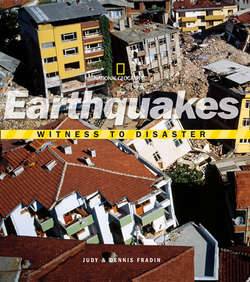Читать книгу Witness to Disaster: Earthquakes - National Kids Geographic - Страница 7
CHAPTER 1 “The Ground Would Not Stop Shaking”
ОглавлениеAlaska, 1964
“I turned and watched my house squirm and groan, as though in last mortal agony. It was as though someone had engaged it in a gigantic taffy pull, stretching it, shrinking it, and twisting it.”
Robert B. Atwood, then editor and publisher of the Anchorage Daily Times
The afternoon of March 27, 1964, seemed to be shaping up as a pleasant time for thousands of Alaskans. In Anchorage and other cities, people were heading home from work, preparing dinner, or getting ready for Easter weekend. But then something happened to make that Good Friday a day that Alaskans will never forget. At 5:36 p.m., 13 miles below ground in southern Alaska, massive blocks of rock suddenly shifted and snapped, causing a gigantic earthquake.
“I was next door at my friend Raymond’s house when it started,” Michele Doran recalls about that afternoon. Along with nearly 50,000 other people, eight-year-old Michele lived in Anchorage, Alaska’s biggest city. “We were watching cartoons and dancing. We had experienced lots of small quakes before, so at first we weren’t scared.”
The shaking quickly intensified. “It got a lot worse,” says Michele. “The TV fell and broke. Soon the house was tipping. I couldn’t stand up to get out of the house. I had to crawl on my hands and knees. Then I couldn’t even move but could only lie flat on the floor.
“You know that really loud sound when a jet airplane slows down and reverses its engines? That’s what the earthquake sounded like.”
Michele Doran, who was eight years old and living with her family in Anchorage, Alaska, at the time of the quake
“It came in waves. It would ease up a little, then there’d be a terrible, loud, rolling sound which meant that the really bad shaking was starting again. It happened over and over and over: the loud sound, then the shaking.”
Three hundred miles away in the town of Old Harbor, on Kodiak Island, Viola Simeonoff was having a similar experience. She was at her friend Rundina’s house. “Rundina’s older sister told us we had to get out of the house, but I couldn’t move because the floor was moving funny. Finally I got outside. The ground would not stop shaking—it went on it seemed like forever. When I looked up at the nearby mountainsides, the snow was coming off of them, like giant snowballs rolling down. When it finally stopped, Rundina’s dad told me to go home, that lots of water would be coming.”
During the five minutes it lasted, the quake caused enormous damage across 50,000 square miles of Alaska. Giant cracks split the ground. Landslides and avalanches hurled huge amounts of dirt, rocks, ice, and snow down mountain slopes. Buildings swayed and fell. Railroad tracks twisted. Bridges collapsed. Cars bounced up and down as if on trampolines. Twenty people lost their lives. Three-quarters of the city of Anchorage was damaged or destroyed.
But the Good Friday Earthquake held another danger. As the father of Viola’s friend warned, lots of water would be coming.
Earthquakes that originate beneath or near the ocean can disturb the water, creating tsunamis. These waves, which travel at speeds of more than 500 miles per hour, are not very tall when out at sea. As they approach shore, however, tsunamis pile up into giant walls of water that flatten everything in their path.
WITNESS TO A TSUNAMI
“Dad was the last one to get up on the roof. Just as he did, the wave hit. It was enormous. The wave destroyed everything in the neighborhood except the house we were on. It was ripped off the foundation and we were sent spinning around in the water as we hung on to the roof shingles. I felt like I was in the house in The Wizard of Oz. I saw our car float by. We swirled around in the water for 15 or 20 minutes until the house got stuck in some trees about a mile from where we started.”
Linda McRae MacSwain, then 15 years old, recalling how she and her family survived the tsunamis on a rooftop in Seward, Alaska
Alaska’s Good Friday Earthquake, which originated near an ocean inlet named Prince William Sound, generated huge tsunamis. A few minutes after the quake, one tsunami approached Valdez, Alaska. The 30-foot wave ripped away a dock and drowned 28 people before destroying much of the town.
At about the same time, a 70-foot wave struck Chenega, a Native-Alaskan community on an island in Prince William Sound. Twenty-three of the village’s 76 residents drowned.
Twenty minutes after the quake, a 40-foot-high tsunami slammed into Seward. It was followed by five more waves over the next few hours. Tsunamis barraged the town of Kodiak roughly once an hour until 3 a.m. Most of downtown Kodiak was destroyed. When contacted by radio, one captain reported that his fishing boat had landed safely—five blocks from shore behind a schoolhouse.
At Old Harbor, town leaders knew that tsunamis would follow such a strong quake, and they directed people to high ground. Many of Old Harbor’s 200 residents, including Viola Simeonoff, spent the night on a hill. “All night, we heard wave after wave banging against the houses below,” she says. “In the morning I saw that the water had destroyed our whole town.”
Tsunamis created by the quake traveled far beyond Alaska. In the middle of the night, four slammed into Crescent City, California, 1,700 miles from Anchorage.
In all, Alaska’s Good Friday Earthquake took approximately 132 lives—most of them in the tsunamis. Besides the human loss, $750 million in property (equal to $4.5 billion today) was destroyed by the most powerful North American earthquake ever recorded.
